How To Use Two Sim Cards In One Phone
Just about every cellular telephone in existence today makes use of a SIM card. "SIM" is short for Subscriber Identity Module. Without it, yous tin can't make or receive phone calls. You lot also tin can't use any internet data over a cellular connection.
You probably already knew this, but why is your telephone and then useless without this small piece of metal and plastic? Just what is a SIM card actually used for?
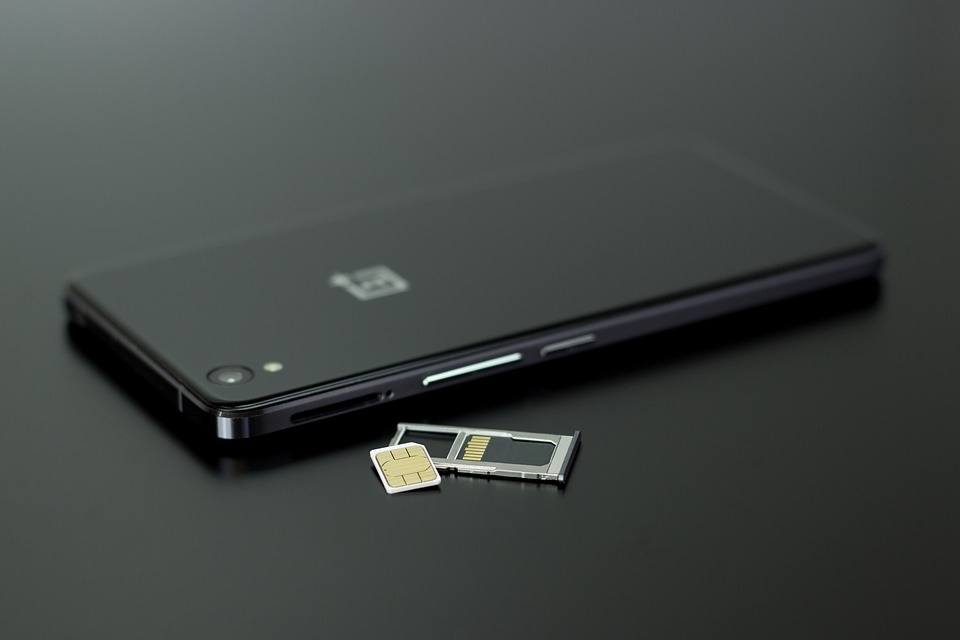
What a SIM Card Looks Similar
A SIM Carte du jour is pretty easy to identify. It's a plastic card with a distinct set of metal contacts. Inside the SIM carte you'll find an integrated excursion, which communicates with the phone through the aforementioned metal contacts.
SIM cards come in a multifariousness of shapes and sizes. In fact, there are iv sizes in total. The largest is known equally "full-size" and is effectively obsolete. Measuring three.37 in past two.125 in, full-size SIM cards were basically the size of smart admission cards.
The reason for this is quite interesting. At the starting time of mobile phone engineering science, multiple people would share a single phone. The idea was that you lot would insert your enormous SIM card into the phone when you wanted to use it. Since the menu would spend more fourth dimension in your wallet than in a phone, the large plastic body made perfect sense.
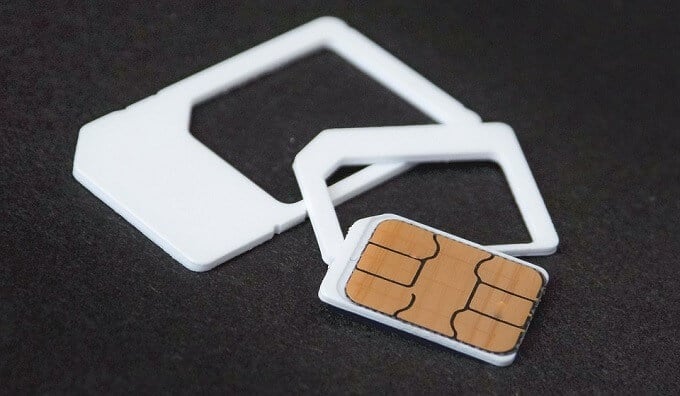
These days most SIM cards you'll buy accept all three of the common sizes, with pieces of the plastic trunk breaking away until you reach the size you want. The Mini-SIM size is pretty uncommon these days and is more often than not used in legacy devices or low-cost devices based on older designs.
The Micro-SIM size is very popular and about mainstream phones use this. The Nano-SIM size eliminates virtually all plastic body around the SIM contacts and is essentially the standard for flagship and mid-high-terminate smartphones, where internal space is at an extreme premium. SIM cards are physically keyed to make it impossible to insert them the incorrect way around.
Hither's a tip: don't throw abroad the Mini- and Micro-SIM frames when you go a new SIM card. If you ever demand to motility the SIM to another phone y'all may still need them!
What Does a SIM Bill of fare Exercise?
The cellular network owned past your service provider is just that – a network. They need to control who has admission to that network both for security reasons and to brand the whole affair piece of work!
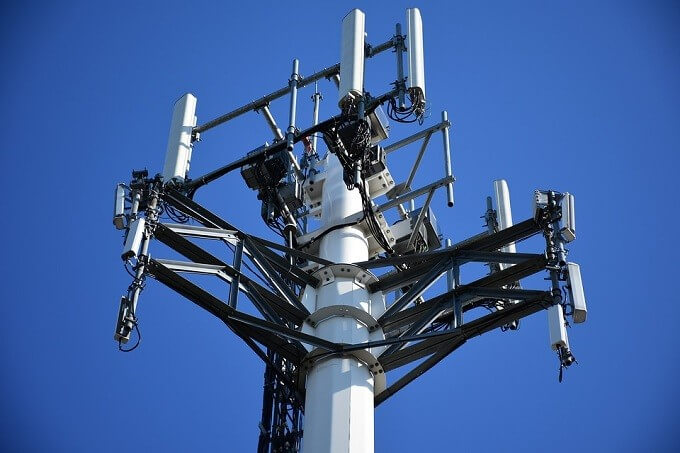
So what is a SIM card? Your SIM card is an admission card. Information technology contains your credentials. So in that sense it's similar a card that stores your username and password. You lot "log in" to the cellular network with the SIM carte. Your phone number is your unique network identity.
No matter where y'all go, as long as you are within range of a cellular tower belonging to your service provider, you can be reached and reach others.
What's Stored On a SIM?
The SIM card has data on information technology that the network needs to authenticate your account. One of these is the ICCID or Integrated Circuit Card Identifier. This is a number that's unique to that specific concrete SIM card.

The side by side important flake of data on the SIM is known as the authentication cardinal. This is a cryptographic primal used to sign information sent to the cellular network. They key is run through a cryptographic part and and then compared to another calculation done with a copy of the key stored in the carrier'southward database. If they match, yous're let onto the network.
The SIM also has memory on it, that yous can use to store your contacts and text messages. This is pretty limited however, with most SIMs sporting betwixt 64k and 256k of space. These days most people are amend off storing their contacts on the phone's own retention, forth with a fill-in using something similar iCloud or their Google account.
Contract and Prepaid SIM Cards
There are more often than not ii models cellular providers utilise to sell their services to customers. You lot can sign a fixed contract agreement, or yous tin can exist a prepaid customer.
In both cases, you'll get a SIM carte. The cards themselves are no different from each other. Rather, it's how the provider handles the account that sets them apart. You lot can buy prepaid SIM cards off the shelf. Although in many countries you must register the purchase, using regime ID and proof of residence.

Contract SIM cards are allocated information, talk time and other resources according to your contract. Overages are added to your bill and at the terminate of the billing bicycle the money gets deducted from your business relationship. With prepaid cards, you'll usually load a monetary amount onto the SIM or otherwise purchase talk time or mobile data upfront.
Depending on where yous live, certain contract handsets may be locked to SIM cards only from that provider. Often this is a way to get a phone for a substantial discount, but if you e'er need to use another SIM card, perhaps when travelling, you'll find that it doesn't piece of work! To avert that sort of state of affairs, be sure to await for phones sold as "unlocked".
Switching SIM Cards
Taking a SIM from one phone and moving it to another is pretty painless. Given that both phones apply the aforementioned SIM card size. If the other phone uses a larger size, you'll have to employ an adapter to brand information technology fit the larger slot. If the SIM card you want to use is too large for the target phone, y'all accept two choices.
The beginning is to cut the SIM downwardly to size. Some people are brave plenty to do this using nothing only a pair of scissors and some sort of template. If you accidentally cut into the circuity of the SIM carte du jour, it'due south game over and you lot'll need a new one. The safest style to do this is by using a dedicated SIM cutting tool. Fifty-fifty so, yous run the risk of destroying the card, then take this route only at your own take a chance.
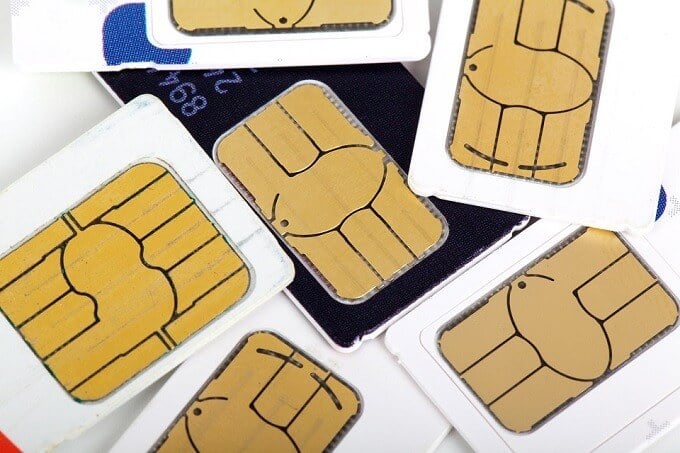
The other option is to switch SIM cards. Of course, if you just went out and bought a new SIM card, it would have a dissimilar phone number associated with it! Each service provider may have a different procedure to move your telephone number from one SIM to another.
In general notwithstanding, information technology should simply take a phone call and verification of your identity. If the provider has physical stores, you should even accept the option of going in for a new SIM, with your old ane disabled.
These days it'southward popular to use text letters sent to specific SIM cards as a form of 2-cistron authentication. And then now nosotros have something known as SIM-swap fraud. Where criminals observe ways to accept your phone number transferred to a SIM they control. SIM duplication is another method. Information technology'southward certainly something to scout out for.
Life Subsequently SIM Cards
SIM cards, at least discrete SIM cards, aren't really necessary anymore. We are already seeing the ascension of the eSIM or embedded SIM card. This is a SIM card congenital directly into the phone. This card is programmable, which means you can hands change providers or employ multiple providers at one time.
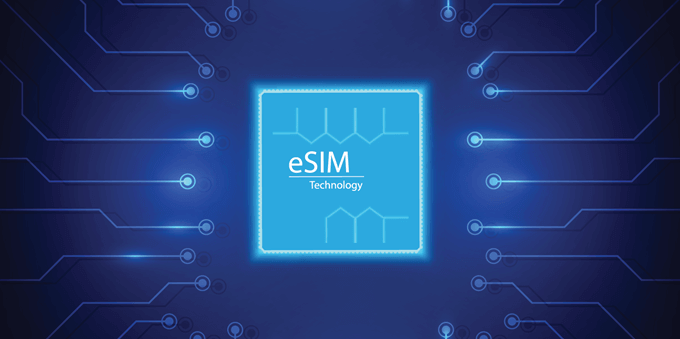
In some countries, "dual-SIM" phones accept been very popular. With these you lot could have two phone numbers, one for personal use, for example. Yous could also have a dedicated information SIM card, perhaps with improve rates.
eSIMs brand this redundant and turns access and hallmark into something like to fixed-line broadband usage. Where you simply enter a username and password to access a given service provider.
Few current phones accept embedded SIM cards at the time of writing, but that's set to alter as the industry adopts this new standard. You lot next phone might very well have no place to put a SIM card at all, which would be the end of an era, merely certainly a move for the better.
Do not share my Personal Data.
How To Use Two Sim Cards In One Phone,
Source: https://www.online-tech-tips.com/smartphones/what-is-a-sim-card-used-for/
Posted by: walkerdeboyfaing.blogspot.com


0 Response to "How To Use Two Sim Cards In One Phone"
Post a Comment